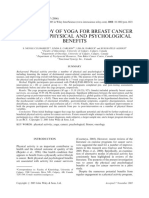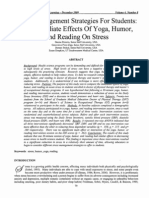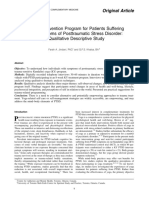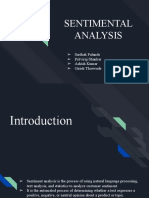504 Quantitative Research
504 Quantitative Research
Uploaded by
api-282538590Copyright:
Available Formats
504 Quantitative Research
504 Quantitative Research
Uploaded by
api-282538590Original Title
Copyright
Available Formats
Share this document
Did you find this document useful?
Is this content inappropriate?
Copyright:
Available Formats
504 Quantitative Research
504 Quantitative Research
Uploaded by
api-282538590Copyright:
Available Formats
Running head: EFFECTS OF YOGA ON STRESS OF GRADUATE STUDENTS
Effects of Yoga on Perceived Stress Levels of Occupational Therapy Graduate Students
Jennifer Godfrey, Annie Guiliano, Danielle Palmer, and Brianna Pupp
Touro University Nevada
EFFECTS OF YOGA ON STRESS OF GRADUATE STUDENTS
Results
Information on Participants and Data Collection
The participants were recruited via electronic mail (email). The mass email was sent to
all Touro University Nevada occupational therapy graduate students in cohort 2015 and cohort
2016 over a two week period using convenient sampling. A total of sixty-five people were asked
to volunteer and thirty participants were to be randomly assigned equally into a control and
experimental group. Eleven people responded to the recruitment email, the additional nineteen
people were recruited in class and asked if they were willing to participate in the study. Of the
eleven students that volunteered, four of the students asked to participate in person were assigned
to the treatment group. The remaining fifteen participants recruited in person were assigned to
the control group. The ages of the participants ranged from twenty-two to forty-four and there
were two males and twenty-eight females. Randomization was not attained due to the lack of
volunteers and the need to directly ask students to participate in the study. The experimental
group contained nine students from cohort 2016 and six students from cohort 2015. The control
group consisted of fifteen students from cohort 2016. One hundred percent of the thirty
participants completed the research study.
Data Analysis
Treatment Group
Control Group
30
40
21.9
20.8
20
10
Perceived Stress
Perceived Stress
40
37.3
39.9
30
20
10
0
0
Pretest
Post Test
Pretest VS Posttest
Pretest
Post Test
Pretest VS Posttest
EFFECTS OF YOGA ON STRESS OF GRADUATE STUDENTS
Implications for Practice
Unmanaged stress can become a chronic health issue and many life threatening
conditions, such as heart problems, high blood pressure, and diabetes, are associated with
constant levels of high stress (Collingwood, 2007). Unmanaged stress is also an important issue
because occupational therapists risk professional burnout due to chronic work stress (Rogers &
Dodson, 1988). Research has shown that yoga can decrease overall stress and improve wellbeing by decreasing signals sent to the autonomic nervous system that keep the body in constant
stress (Smith, Greer, Sheets, & Watson, 2011). Stress has been shown to be prevalent in graduate
students and it is important to find different ways to combat stress that do not involve spending
profuse amounts of money or by taking medication (Beck & Verticchio, 2014).
All participants in the treatment group received a yoga packet by email containing a yoga
questionnaire, a record log to track participation, a yoga booklet for instruction, and two Sheldon
Cohen Perceived Stress Scales. The questionnaire was completed by the participants to establish
their yoga history and any other stress reduction techniques they utilize. The sample size was
small and did not identify any dominant trends. Compliance was one hundred percent with zero
percent morbidity. Both the treatment group and control group were given the Perceived Stress
Scale before the study to establish baseline and two weeks later after the completion of the yoga
stretching program. The descriptions and pictures of the yoga stretches were only given to the
treatment group. The booklet contained instructions for five different yoga stretches that the
participants of the treatment group completed on Tuesday, Thursday, and Saturday nights before
bed. Each yoga stretch was to be held for three minutes before moving onto the next step in the
sequence of stretches. The treatment group filled out a record log to track participation. All data
EFFECTS OF YOGA ON STRESS OF GRADUATE STUDENTS
was collected after two weeks and put into excel spreadsheets. There were two categories of data
collected, treatment pre and posttest and control pre and posttest data.
The research question focused on the relationship between perceived stress levels of
occupational therapy graduate students at Touro University Nevada and participation in yoga
stretching. The formulated hypothesis predicted there would be a decrease in perceived stress
levels of the treatment group after completion of the yoga stretching program. After analysis of
the results, the data from the study supported the hypothesis. The data showed the control
groups perceived stress levels increased between the pretest and posttest. The data also showed
the treatment groups perceived stress levels decreased between the pretest and posttest. The
treatment group completed six yoga sessions between the pretest and posttest.
Our research study shows that yoga stretching can decrease perceived stress levels of
occupational therapy graduate students, however, there were many limitations within the study.
The first limitation was the small sample size which consisted of less than 50 participants, this
decreased the validity of the study. The second limitation of the study was the weekly record
logs and questionnaire were self-reported by the treatment group. In future studies, it is
recommended a yoga group be implemented for accountability and encouragement among
participants. The yoga stretches would be practiced together so they would be completed
correctly and to the specifications of the yoga instructor. A third limitation would be the
environment in which the participants completed their yoga stretching sessions. With the
treatment group completing the yoga stretches in their own homes, there were a variety of
environments utilized that may not have been conducive to a true yoga stretching experience. In
future studies, the yoga stretching should be done in a professional yoga environment, such as a
yoga studio. The yoga stretches were not taught, the participants were given a booklet of written
EFFECTS OF YOGA ON STRESS OF GRADUATE STUDENTS
instruction with pictures. This should also be corrected by having a certified yoga instructor lead
the yoga group. Another limitation was the control group consisted of graduate students from
cohort 2016, while the treatment group was a mixture of both cohort 2015 and cohort 2016. In
future studies the control and treatment group should contain an even composite of cohort 2015
and cohort 2016. A final limitation, cohort 2015 may have established better stress reduction
techniques. Cohort 2015 students may have decreased perceived stress levels because they have
had a year to acclimate to their coursework and the educational demands placed on them
compared to cohort 2016. Since the perceived stress levels decreased in the treatment group, the
idea of teaching yoga stretching as part of orientation or as part of the curriculum to the
occupational therapy graduate students would be a great preventative measure to keep perceived
stress levels low. Teaching occupational therapy students better stress reduction techniques, like
yoga stretching, will ultimately increase overall health and prevent professional burnout.
EFFECTS OF YOGA ON STRESS OF GRADUATE STUDENTS
References
Beck, A. R., & Verticchio, H. (2014). Facilitating Speech-Language Pathology Graduate
Students Ability To Manage Stress: A Pilot Study. Contemporary Issues In
Communication Science & Disorders, 4124-38.
Collingwood, J. (2007). The physical effects of long-term stress. Psych Central. Retrieved on
October 12, 2014, from http://psychcentral.com/lib/the-physical-effects-of-long-termstress/000935
Smith, J.A., Greer, T., Sheets, T., & Watson, S. (2011). Is there more to yoga than exercise?
Alternative Therapies 17(3), 22-29.
Rogers, J. C., & Dodson, S. C. (1988). Burnout in Occupational Therapists. American Journal of
Occupational Therapy, 42(12), 787-792. doi: 10.5014/ajot.42.12.787
You might also like
- Information On Participants and Data CollectionDocument4 pagesInformation On Participants and Data Collectionapi-292429451No ratings yet
- The Effects of Yoga On Stress and Anxiety in College StudentsDocument2 pagesThe Effects of Yoga On Stress and Anxiety in College StudentsLleNo ratings yet
- School of Occupational Therapy Touro University Nevada: Focused QuestionDocument11 pagesSchool of Occupational Therapy Touro University Nevada: Focused Questionapi-255001706No ratings yet
- Paper 06Document4 pagesPaper 06Dr Vikash Kumar TiwariNo ratings yet
- J JBMT 2019 05 013Document7 pagesJ JBMT 2019 05 013ankitaghivareNo ratings yet
- Trauma-Sensitive Yoga - Principles, Practice and ResearchDocument6 pagesTrauma-Sensitive Yoga - Principles, Practice and ResearchRichard Guerra100% (1)
- 9624-Article Text-27594-1-10-20170729Document11 pages9624-Article Text-27594-1-10-20170729DOMENIQUE BENITEZNo ratings yet
- AP Research Model Paper YogaDocument21 pagesAP Research Model Paper Yogaitzys.izzyNo ratings yet
- Research Article: Medical Students' Stress Levels and Sense of Well Being After Six Weeks of Yoga and MeditationDocument8 pagesResearch Article: Medical Students' Stress Levels and Sense of Well Being After Six Weeks of Yoga and Meditationsankapalrutik10No ratings yet
- Psycho OncologyDocument7 pagesPsycho Oncologysankapalrutik10No ratings yet
- Rizzolo (2009) Yoga, Humor, and Reading On StressDocument11 pagesRizzolo (2009) Yoga, Humor, and Reading On StressSamue W. RootNo ratings yet
- Brief Impact of A Yoga and Meditation Intervention On Students' Stress and Anxiety LevelsDocument6 pagesBrief Impact of A Yoga and Meditation Intervention On Students' Stress and Anxiety LevelsLie LhianzaNo ratings yet
- An Individualised Yoga Programme For Multiple Sclerosis - A Case StudyDocument22 pagesAn Individualised Yoga Programme For Multiple Sclerosis - A Case StudyShubhi TanejaNo ratings yet
- Medical Students' Stress Levels and Sense of Well Being After Six Weeks of Yoga and MeditationDocument7 pagesMedical Students' Stress Levels and Sense of Well Being After Six Weeks of Yoga and Meditationiitd.adgpNo ratings yet
- Mind-Body Medicine Yang-Sheng 2012-05Document6 pagesMind-Body Medicine Yang-Sheng 2012-05Budo MediaNo ratings yet
- TSY - Principles, Practices, and ResearchDocument6 pagesTSY - Principles, Practices, and ResearchsimonyanNo ratings yet
- Yin Yoga and Mindfulness: A Five Week Randomized Controlled Study Evaluating The Effects of The YOMI Program On Stress and WorryDocument15 pagesYin Yoga and Mindfulness: A Five Week Randomized Controlled Study Evaluating The Effects of The YOMI Program On Stress and Worrykamblineha0No ratings yet
- MRD Synthesis SummativeDocument11 pagesMRD Synthesis Summativeapi-360237033No ratings yet
- Saint Paul University Philippines: Advanced Adult Nursing 2Document6 pagesSaint Paul University Philippines: Advanced Adult Nursing 2John Ralph VegaNo ratings yet
- Acm 2017 0046Document2 pagesAcm 2017 0046kamblineha0No ratings yet
- Sweta Research ProposalDocument7 pagesSweta Research ProposalamanNo ratings yet
- A Review On Psycho Physiological Impacts of Yoga On Anxiety in Undergraduate StudentsDocument3 pagesA Review On Psycho Physiological Impacts of Yoga On Anxiety in Undergraduate StudentsresearchparksNo ratings yet
- Effectiveness of Yoga Therapy On Psychological Well-Being Among School StudentsDocument8 pagesEffectiveness of Yoga Therapy On Psychological Well-Being Among School Studentsdesobarman1No ratings yet
- 21-Aug-YOGA.inddDocument4 pages21-Aug-YOGA.inddMarcela MölkNo ratings yet
- Z Muthamia Research YogaDocument14 pagesZ Muthamia Research Yogaapi-247838667No ratings yet
- Integrative Review of The LiteratureDocument19 pagesIntegrative Review of The Literatureapi-662817877No ratings yet
- Effectiveness of Mindfulness Intervention in Reducing Stress and Burnout For Mental Health Professionals in SingaporeDocument26 pagesEffectiveness of Mindfulness Intervention in Reducing Stress and Burnout For Mental Health Professionals in SingaporeMuqaddas GhoriNo ratings yet
- Uprak Rubrik Bu IzfaaizahDocument12 pagesUprak Rubrik Bu IzfaaizahMaya Ulfah apriliyaNo ratings yet
- Pon 1503Document9 pagesPon 1503kamblineha0No ratings yet
- 70 HartfielDocument8 pages70 HartfielDulantha SrimalNo ratings yet
- Behavioral SciencesDocument11 pagesBehavioral SciencesNoor ul HudaNo ratings yet
- NurseMediaJournalofNursing pdf2EEFECTYOGADocument11 pagesNurseMediaJournalofNursing pdf2EEFECTYOGADinesh SNo ratings yet
- 1 s2.0 S0965229921000534 MainDocument6 pages1 s2.0 S0965229921000534 MainperawatnanggroeNo ratings yet
- The Immediate and Durable Effects of Yoga and Physical Fitness Exercises On StressDocument10 pagesThe Immediate and Durable Effects of Yoga and Physical Fitness Exercises On Stressharshadpardeshi45No ratings yet
- JogamayaDocument39 pagesJogamayaBK ShoraishamNo ratings yet
- PRBM S157503Document9 pagesPRBM S157503ankitaghivareNo ratings yet
- Journal of Yoga & Physical TherapyDocument12 pagesJournal of Yoga & Physical Therapykhadesakshi55No ratings yet
- Yoga: Potential Benefits For Persons Who Stutter: Heather KauffmanDocument7 pagesYoga: Potential Benefits For Persons Who Stutter: Heather Kauffmankhadesakshi55No ratings yet
- La Aviv DesignsDocument6 pagesLa Aviv DesignsjacobNo ratings yet
- Effectiveness of A Mindfulness-Based Programme On Perceived Stress, Psychopathological Symptomatology and Burnout in Medical StudentsDocument10 pagesEffectiveness of A Mindfulness-Based Programme On Perceived Stress, Psychopathological Symptomatology and Burnout in Medical StudentsPereNo ratings yet
- Acm 2014 0262Document8 pagesAcm 2014 0262khadesakshi55No ratings yet
- Yoga For COPD PublicationDocument7 pagesYoga For COPD PublicationMariani RasyidNo ratings yet
- MAKALEDocument8 pagesMAKALEemreakinay84No ratings yet
- AaaBiochemical and Psychometric Evaluation of Self-Healing Qigong As A CHANDocument5 pagesAaaBiochemical and Psychometric Evaluation of Self-Healing Qigong As A CHANMozagnes AgnesNo ratings yet
- EngstromDocument15 pagesEngstromapi-677679764No ratings yet
- Ferreira-Vorkapic Et Al., 2015 Are There Benefits From Teaching Yoga at Schools A Sytematic ReviewDocument17 pagesFerreira-Vorkapic Et Al., 2015 Are There Benefits From Teaching Yoga at Schools A Sytematic ReviewDANIEL MAURICIO RIOBO MOLANONo ratings yet
- The Effects of Mindfulness Meditation On Anxiety Reduction in College StudentsDocument2 pagesThe Effects of Mindfulness Meditation On Anxiety Reduction in College Studentskjsingh01No ratings yet
- SUSANJINCYDocument4 pagesSUSANJINCYbanaralasNo ratings yet
- Effects of Mindfulness and Meditation On Teacher Stress and Self Research ProposalDocument8 pagesEffects of Mindfulness and Meditation On Teacher Stress and Self Research ProposalBenjie RudaNo ratings yet
- Vancampfort - State Anxiety, Psychological Stress and Positive Well-Being Responses To Yoga and Aerobic Exercise in People With Schizophrenia A Pilot Study.48Document7 pagesVancampfort - State Anxiety, Psychological Stress and Positive Well-Being Responses To Yoga and Aerobic Exercise in People With Schizophrenia A Pilot Study.48Beto RebolledoNo ratings yet
- Effectiveness of Aerobic Exercises On StressDocument20 pagesEffectiveness of Aerobic Exercises On StressRegina EstherNo ratings yet
- Yoga (4) TM 3Document7 pagesYoga (4) TM 3dinaamparan34No ratings yet
- Original Research Paper PsychologyDocument3 pagesOriginal Research Paper PsychologyDishuNo ratings yet
- Qigong For The Mental Health of Teachers A Pro 2023 Brain Behavior and ImmDocument7 pagesQigong For The Mental Health of Teachers A Pro 2023 Brain Behavior and ImmKourosh PourramezanNo ratings yet
- Meditation and Yoga As Alternative Therapy For Primary DysmenorrheaDocument6 pagesMeditation and Yoga As Alternative Therapy For Primary DysmenorrhearifdaNo ratings yet
- Yoga and MPADocument13 pagesYoga and MPAEsteban Navarro DíazNo ratings yet
- Artigo Metaanalise PsicosomaticaDocument18 pagesArtigo Metaanalise Psicosomaticafhenrique77No ratings yet
- Eastdis 2015 07 036Document5 pagesEastdis 2015 07 036khadesakshi55No ratings yet
- Artigo 2Document7 pagesArtigo 2Marina PradoNo ratings yet
- STUDY OF THE INFLUENCE OF ART THERAPY ON THE FORMATION OF THE INTERNAL SUPPORT OF THE PERSONALITYFrom EverandSTUDY OF THE INFLUENCE OF ART THERAPY ON THE FORMATION OF THE INTERNAL SUPPORT OF THE PERSONALITYNo ratings yet
- Tws 6 Final 2Document4 pagesTws 6 Final 2api-213553729No ratings yet
- How To Ace Your EE ReflectionsDocument2 pagesHow To Ace Your EE ReflectionsMeredith AyazNo ratings yet
- X2 Test (Chi Squared Test)Document5 pagesX2 Test (Chi Squared Test)Paewa PanennungiNo ratings yet
- WEEK 1 5 Feasibility StudyDocument9 pagesWEEK 1 5 Feasibility StudyJACQUELYN ESPADONNo ratings yet
- Memory of The World: CII-96/WS-7Document39 pagesMemory of The World: CII-96/WS-7Talia GarzaNo ratings yet
- Policy and Procedure With The Steps Involved in Jcaho's CycleDocument15 pagesPolicy and Procedure With The Steps Involved in Jcaho's Cycleالمعتزبالله جاب اللهNo ratings yet
- Being A Leader EssayDocument8 pagesBeing A Leader Essaynhbtoxwhd100% (2)
- Theoretical Framework JWPN 1bDocument5 pagesTheoretical Framework JWPN 1bSalwani ShafieNo ratings yet
- ACE Learning Ecosystem - Standards and PrinciplesDocument29 pagesACE Learning Ecosystem - Standards and PrinciplesDonna KellyNo ratings yet
- Hfle U 2 Lesson PlanDocument4 pagesHfle U 2 Lesson Planapi-297677257No ratings yet
- Sentimental Analysis Final Year ProjectDocument21 pagesSentimental Analysis Final Year ProjectAmitNo ratings yet
- Marketing Management CourseDocument3 pagesMarketing Management CourseHarveen KaurNo ratings yet
- Li ChunDocument21 pagesLi ChunADRC ScotlandNo ratings yet
- Observations On The Ternary Cubic Equation: S.Vidhyalakshmi, M.A.Gopalan, A.KavithaDocument6 pagesObservations On The Ternary Cubic Equation: S.Vidhyalakshmi, M.A.Gopalan, A.KavithaInternational Journal of computational Engineering research (IJCER)No ratings yet
- SSC CHSL MAINS 2024 Mock Test - 07Document21 pagesSSC CHSL MAINS 2024 Mock Test - 07Bikram SarkarNo ratings yet
- 40 Nov c114Document9 pages40 Nov c114bt20103120 Bharat SinghNo ratings yet
- Mine IlluminationDocument12 pagesMine Illuminationgharonk MukharrorNo ratings yet
- Compliance With Hand Therapy Programs - Therapist and Patients PerceptionsDocument10 pagesCompliance With Hand Therapy Programs - Therapist and Patients PerceptionssammyrasaNo ratings yet
- Organizing Data, Measures of Central Tendency and Dispersion in Frequency DistributionsDocument22 pagesOrganizing Data, Measures of Central Tendency and Dispersion in Frequency DistributionskamranfmsNo ratings yet
- A Companion To Seals in The Middle Ages (Laura J. Whatley (Ed.) ) (Z-Library)Document434 pagesA Companion To Seals in The Middle Ages (Laura J. Whatley (Ed.) ) (Z-Library)szz011No ratings yet
- IHRA Standards For Clinical LabsDocument14 pagesIHRA Standards For Clinical LabsAmir RoufNo ratings yet
- A Research Proposal For Dissertation OnDocument10 pagesA Research Proposal For Dissertation OnSerenityNo ratings yet
- RRLDocument6 pagesRRLChristine May V. AportaderaNo ratings yet
- Public Debt Sustainability A Bibliometric Co Citation Visualization AnalysisDocument21 pagesPublic Debt Sustainability A Bibliometric Co Citation Visualization AnalysisKermel FouekenNo ratings yet
- Thesis On Quality Service DeliveryDocument7 pagesThesis On Quality Service Deliveryjennysmithportland100% (2)
- Mco 22Document6 pagesMco 228dgoosepumpsNo ratings yet
- Microeconomics Assignment 1: I 2i 3i 4iDocument5 pagesMicroeconomics Assignment 1: I 2i 3i 4iYash AgarwalNo ratings yet
- Mstoll CV 2016 v1Document11 pagesMstoll CV 2016 v1api-233472373No ratings yet
- Wa Pay Sure NiDocument29 pagesWa Pay Sure NiCharles Elquime GalaponNo ratings yet
- CAS Student HandbookDocument24 pagesCAS Student HandbookivyNo ratings yet

























































































